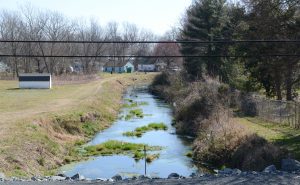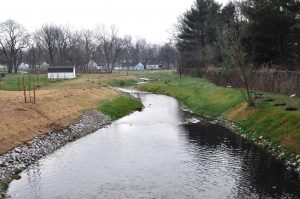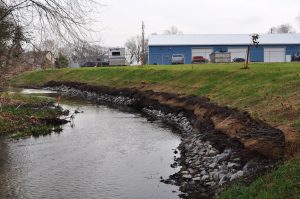
Facebook Twitter Instagram YouTube RSS Feed
Written on: May 22nd, 2017 in Wetland Restorations
Guest Writer: Melissa Hubert, DNREC’s Drainage Program
Fun fact, did you know that there are 234 tax ditch organizations scattered across Delaware that provide water management services to over 100,000 residents and nearly half of the state-maintained roads?
These watershed based organizations are responsible for maintaining over 2,000 miles of ditch channel to ensure the drainage functionality of these systems stays running strong. This is no easy feat considering most tax ditches were constructed over 30 years ago when the landscape across Delaware looked much different. The aging infrastructure of most tax ditches in conjunction with landuse changes have resulted in major maintenance concerns that need to be addressed.

Conditions of the Bridgeville Branch Tax Ditch channel before the stream restoration project. Note the straight channel.
As these engineered systems attempt to handle stormwater flows that they were not designed for, the ditch channels often undergo changes caused by moving water that deepen and widen the channels, cause bank erosion, and create sediment bars. These side-effects change the ditch systems from their original designs which in turn, may limit their water capacity, decrease response time to storm events, and make it more difficult to perform channel maintenance.

Bridgeville Branch Tax Ditch channel after the stream restoration project was completed. Note the meander of the channel, which is similar to the flow of natural streams
The DNREC Drainage Program is working with tax ditch organizations to determine ways to mimic natural in-stream processes and features with the goal of minimizing maintenance needs while still enhancing the ability of these systems to transport and clean water.
Here’s an example of one of those projects:
A portion of the Bridgeville Branch Tax Ditch, located in the Town of Bridgeville, was undercutting and widening to the point that both a sanitary sewer and water line were exposed within the channel. For a permanent solution to this serious issue, the exposed lines were properly encased and a channel that mimics a natural stream was constructed to further protect and enhance the project area.

Soil lifts with live branch cutings placed between each layer to protect this bend where the sanitary sewer line is located and improve in-stream habitat.
Natural streams transport water through the path of least resistance and as a result, many twists and turns tend to develop as water moves. For this project the ditch channel was re-aligned to establish a meandering flow path with adjacent floodplain benches to reduce the energy moving through the channel during normal and higher storm flow conditions.
In addition a stilling basin was constructed just downstream of four large pipes to slow the water when it entered the project area. A series of riffle and pool structures were created to provide flow diversity within the channel. These features not only reduce future maintenance needs, but capture and prevent pollutants from being transported further downstream, and create spawning habitat for all those critters we love.

The live branch cuttings really taking off providing bank stabilization, wildlife cover, and shade for the channel.
Tree logs and root wads were pushed into the banks to provide natural protection from erosion as well as wildlife habitat and cover. Soil lifts or soils wrapped in an organic material were installed with branches placed between each lift to restore a portion of the ditch bank that was previously lost to erosion.
Last but not least the entire project area was planted with native species of riparian grasses, trees, and shrubs with live branch cuttings planted on the banks to rapidly establish stability, shade, and in-stream cover.
In this project nature was re-engineered by implementing natural design techniques and features that not only improved the functionality of the tax ditch channel and reduced future maintenance needs but also enhanced wildlife habitat and water quality.
It is the DNREC Drainage Program’s hope to help tax ditch organizations plan and construct stream restoration projects like this one to address maintenance issues in the future.
Interested in getting involved? Tax ditch meetings are held annually, organized by watershed, to voice maintenance concerns and other topics. Any decisions are voted on by property owners within their own tax ditch watershed. With the prevalence of tax ditch organizations across Delaware you may even live in a watershed that has one. Check out this app to find out.